
By DINA MANSOUR
On October 25th, 2018, Leaders in Energy (LE), in partnership with the Quebec Government office in Washington and the Embassy of Canada, held a Canada – USA Circular Economy event that started with a short networking breakfast, followed by two panel conferences on the theme “Transforming Waste into Energy to Advance the Circular Economy” at the Embassy of Canada in Washington DC. The panels each featured one company from Quebec, with local American professionals, governments and companies to discuss waste issues and solutions. With over 100 experts in the field in attendance, the event was an opportunity to network, as well to discover the challenges that enterprises and governments are facing and the steps that have been taken to overcome today’s waste problems by including waste generation in a circular economy loop.
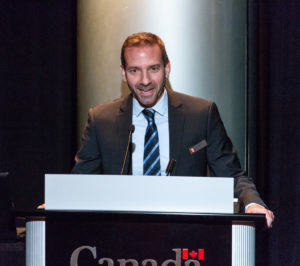
Paul Dallaire, Quebec Government’s food market specialist from the New York Office, launched the event and thanked the organizers. Jason LaTorre, Senior Trade Commissioner and Minister-Counsellor (Commercial Policy) at Embassy of Canada gave opening remarks, followed by Janine Finnell, Leaders in Energy’s Founder and Executive Director, who discussed the circular economy concept and then introduced Robert Lazaro, Executive Director at the Northern Virginia Regional Commission.
Janine spoke about the circular economy initiatives in the DC region and the recent Leaders in Energy events and working group. She explained that the circular economy is becoming a hot topic in the DC area and the efforts to implement it in the region are expanding. She also mentioned the new report on Global Commission on Economy and Climate, which announced a $26 trillion economic opportunity by 2030 for the new climate economy, and includes circular economy as one of its five pillars.
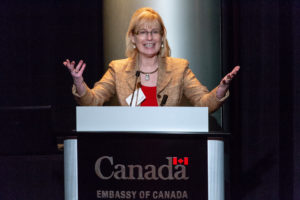
Panel highlights
First panel : “Transforming Waste into Energy to Advance Circular Economy”
Robert Lazaro was the moderator of the first panel “Transforming Waste into Energy to Advance circular Economy”, featuring David McConnell, Vice president at Enerkem, Hans Christensen, Director of Operations at Fairfax County, Adam Ortiz, Director for the Department of the Environment at Prince George’s County and Chris Peot, Director of Resource Recovery at D.C. Water and Sewer Authority. In this panel, participants discussed waste management issues and sustainable solutions to these problems.
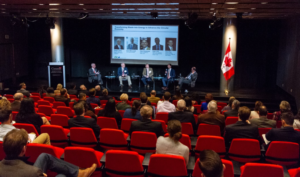
Robert Lazaro, Executive Director at the Northern Virginia Regional Commission
Robert Lazaro started by thanking the organizers and introducing himself, explaining that he has been working in government for the past 38 years, and is a former Mayor of the Town of Purcellville, VA. He mentioned that even at the beginning of his career, “landfills and waste energy plants was the hot topic”, and they “started the first community-wide recycling program” in Rhode Island and New York. He next introduced the first panel participants on stage.
David McConnell, Vice President at Enerkem
David McConnell is Vice President at Enerkem, a Canadian company that started in Quebec, creating an innovative solution to manage and reuse non-recyclable trash. They developed new technologies and installations that can produce biofuels and renewable chemicals from non-recyclable waste materials, which would otherwise end up in landfills. David showed a video demonstrating the impact of trash on the planet and how Enerkem’s technology converts the trash into methanol and ethanol to reuse it. He also commented on how this type of installation can be implemented locally to achieve sustainable waste diversion and provide new sources of fuels.
Hans Christensen, Director of Operations at Fairfax County
Hans Christensen has been in the waste industry for 30 years, and has a degree in law and environmental science. He presented Fairfax County’s Solid Waste Management Program and described the ongoing challenges that the Fairfax County community faces. He said that their main focus is now sustainability, and the decisions taken rely on 3 phases to measure the impacts and feasibility: environmental, financial, social. They have adopted various initiatives to reduce their environmental impact and help preserve the environment, such as, for example, putting bees and pollinators in the facilities.
They currently have 3 facilities that bring many challenges into waste management: one is a collection facility that collects about 10% of the county’s operations, one is a landfill where most of the volume of ashes goes, and the I-66 transfer station facility brings over 1,000,000 tons of waste material per year. They are constrained by both space and cost, and the new sustainability vision hopes to achieve better management and minimize waste.
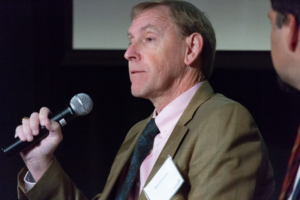
Adam Ortiz, Director of Operations at Prince George County
Adam Ortiz explained how Prince George County has created an entire department dedicated to environment and that they have renamed their solid waste division the “resource recovery division”. They have put a lot of effort into waste diversion and have their own recycling facility, landfills and their own organic compost facility. Through these environmental interventions, they have been able to get their diversion rate—the amount of waste diverted from landfills—up to 65%, the greatest diversion rate in Maryland.
They created a very successful food compost facility that started 6 years ago, which now processes 60,000 tons a year of food scraps. These food materials are collected from different facilities, with over 200 partners, including the University of Maryland and most universities of the region, as well as the Embassy of Canada. It helps divert about 32% of food that would have been going into landfills.
With the facility, they also created a plant nutrition product called “Leaf Grow Gold” that is sold in retailers around the region, and also used in the University of Maryland as a way of creating a circular economy chain.

Chris Peot, Director of Resource Recovery at D.C. Water and Sewer
Chris Peot mentioned that just like Fairfax County, DC has been renaming their departments to reflect more a sustainable focus, such as, for example, “wastewater treatment” becoming “water resource recovery”. He mentioned that the district build a wastewater thermal digester, referred as “blueprint”, that started working 3 years ago and is producing digestate, a solution that comes from the bottom of the digester. This residue is then used by farmers to nourish their land and increase plant growth as a way of contributing to the circular economy by closing the loop.
They also have bees on the facility to produce honey, and they have plans to install 14.5 Megawatts of solar panels. He pointed out that their mantra is “No Such Things as Waste – Only Wasted Resources” and said that it is because “nothing is wasted, it’s all just wasted resources”.
Second Panel: Can Commercial Kitchens Achieve Zero Food Waste?
The second panel “Can Commercial Kitchens Achieve Zero Food Waste?” was moderated by Janine Finnell and featured Caitrin O’Brien, Corporate Sustainability Senior Manager at Hilton, Alain Fecteau, Vice-President at Solucycle, Anica Landreneau, Director of Sustainable Design HOK Architects and Brian Stickel, Former Corporate Executive Chef at Clyde’s Restaurant Group.
Janine Finnell, Leaders in Energy’s Founder and Executive Director
Janine opened the second panel “Can Commercial Kitchens Achieve Zero Food Waste?” with a discussion around the issue of food waste. She quoted a statistic from USDA saying that Americans waste 150,000 tons of food waste a day. “There is about 2000 space shuttles equivalent of food waste every day generated in United States”, she said. “For metropolitan Washington, that equates to about 5 space shuttles of food waste a day.”
She then showed the EPA Food Waste pyramid to kick-off the discussion.

Source : https://www.epa.gov/sustainable-management-food/food-recovery-hierarchy
Caitrin O’Brien, Senior Manager of Corporate Sustainability at Hilton
Caitrin O’Brien manages Hilton’s global environmental sustainability policies and efforts to reduce energy, water and waste. The hotel chain operates in 106 countries within 55,000 facilities across the world. She spoke about Hilton’s sustainability plan, called “Travel with Purpose” and the company’s new corporate sustainability goals that were released last May, where they aim to cut environmental impact in half, and double their positive social impact by 2030. Among those goals, Hilton has set up 23 sub-targets on the environmental and the social side. They also set the goal to reduce their food waste by 50% by 2030 and all their managed hotels to have food donation programs. The WWF worked with the Hilton to understand the food waste in hospitality in partnership with the American Hotel & Lodging Association, to develop a Hotel Kitchen toolkit available online at www.hotelkitchen.org, for reducing food waste in the industry. They conducted waste reduction pilots in 45 different Hilton hotel locations around the world that they then integrated as part of their hotels program, where every hotel in their portfolio is required to follow food waste reduction actions following the EPA’s Food Recovery Hierarchy. Buffets served at meetings, events and as hotel breakfast are the biggest source of food waste, she said, and they are working to provide smaller, but higher quality meals with better meal size preparation to meet the demand and to avoid food waste, as food donations aren’t permitted in various countries outside of the US due to legislation.
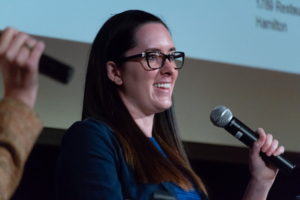
Alain Fecteau, Vice-President at Solucycle
Solucycle was the second Canadian company from Quebec that presented at event. Their focus is in food waste management in commercial kitchens. The founders created a technology able to manage food waste efficiently in kitchens and to reuse it as compost or biogas. They are even working on new possibilities of reusing as animal feed. Alain showed a demonstration video to explain how the Solucycle ‘robot’ works. It looks like a trash chute that grinds all the food leftovers and the main equipment doesn’t take up more space than a trash can and doesn’t generate odors. It then sends it to a tank that keeps the food sealed in a liquid form described as a “slurry”. Once the tank reaches capacity, a local partner comes to pick it up and to send it to compost or a biogas facility to reuse it. They call it a “robot” because it has both a mechanical and an intelligent component to it. The robot is able to track the amount of food waste that it processes as well as the real-time status of the tank. It also creates automatic environment and management reports to indicate, for example, how much CO2 the company has saved or compare the volumes of food wasted between different robots installed in different locations from the same company. It is also possible to control the ‘robot’ remotely, and it is linked to an app, where the user can keep track of all the information, reports, and food collecting schedules. It is a true innovation in terms of food waste management and the circular economy!

Anica Landreneau, Director of Sustainable Design HOK Architects
HOK is an international design firm, involved in architecture, but also engineering, urban design and planning, interiors, consulting, lighting design and a broad range of other services. They are located in various cities in the world, including 3 in Canada. Anica highlighted that they work in a broad range of markets with a large volume of potential food waste, such as in hotels, universities, convention centers, sports venues, hospitals, etc. She mentioned that they also work on bigger projects that involve infrastructure, and that it is crucial to think about food waste and net zero impact from the beginning of the project in a closed loop cycle. Corporations and municipalities should start thinking about these issues from the beginning point of the construction, she says, in order to successfully implement food-waste prevention mechanisms. To achieve this, HOK committed to set a target for environmental progress in their clients’ portfolios, and to move their entire portfolio designs to net zero carbon by 2030.
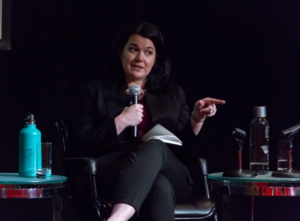
Brian Stickel, Former Corporate Chef for Clyde’s Restaurant Group
Brian worked as a corporate chef at Clyde’s Restaurant Group, that has 13 restaurants in the DC Metro Area. Brian explained, from the point of view of a restaurant chef, how it is possible to reduce food waste in a restaurant. He mentioned the Oyster recovery program, where the Clyde’s Restaurant Group sells more oysters on the East Coast than anyone else, so they save the oyster shells and they smell after a while, so they have to refrigerate them. They then recycle them by sending them to another facility, where they get broken up, crushed, and they are used as new oyster beds on the Chesapeake Bay to restore the oyster population.
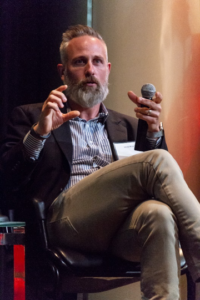
He also mentioned that new technologies, such as Solucycle’s robot, are helping to avoid wasting food in different ways, such as, for example, the sous-vide way to cook food and preserve it for up to 3 months, while keeping the quality; ovens that avoid burning food (another way a lot of food is wasted in the restaurant industry); and a technology that tracks the fridge and sends alerts when some food in the fridge is about to go bad.Brian mentioned that over-purchasing food is a big issue that leads to waste, and that ultimately every restaurant’s goal is to avoid waste. He also mentioned that there are other ways of reducing waste other than donation, such as reusing cooking leftover scraps and bones to make other kind of foods that require these parts.
The event ended on a note from Charles Girard, Energy Attaché at the Quebec Government Office in Washington, who highlighted the efforts of Quebec companies for finding solution to today’s waste problems globally and changing the vision of energy for the future. He also thanked the panelists, as well as the event partners and organizers.

Dina Mansour is a current Master student in International Business at HEC Montreal. She is also an intern at the Quebec Government Office in Washington DC. Dina loves traveling and learning about languages and culture, and speaks French, English, Spanish, Arabic, Italian. She discovered her interest in sustainability while in Washington DC.



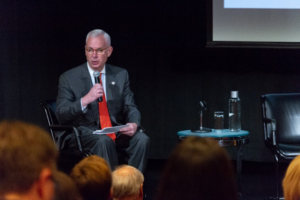
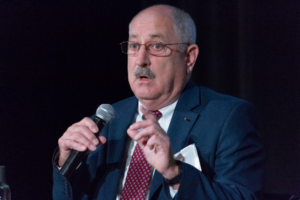
Leave a Reply